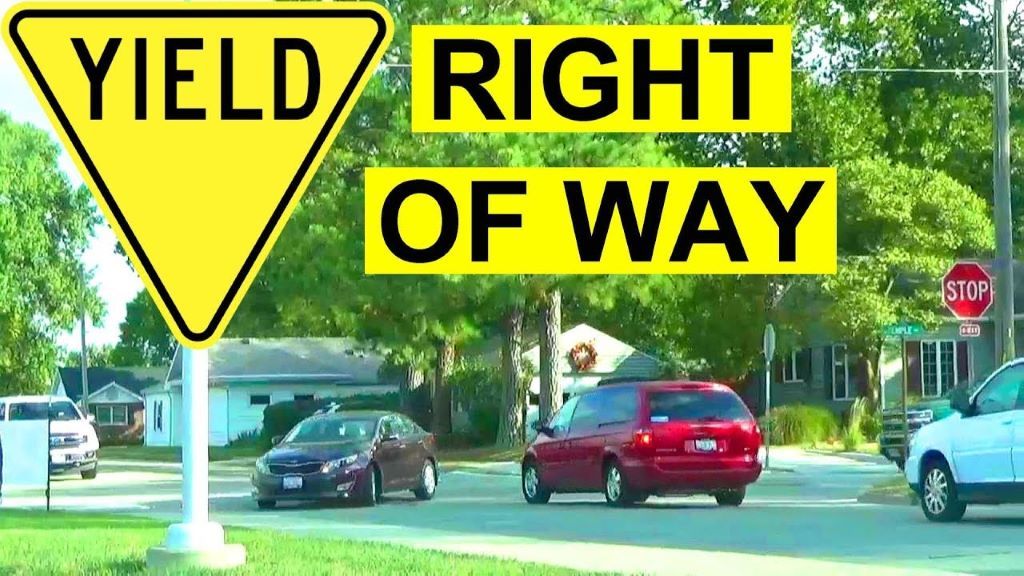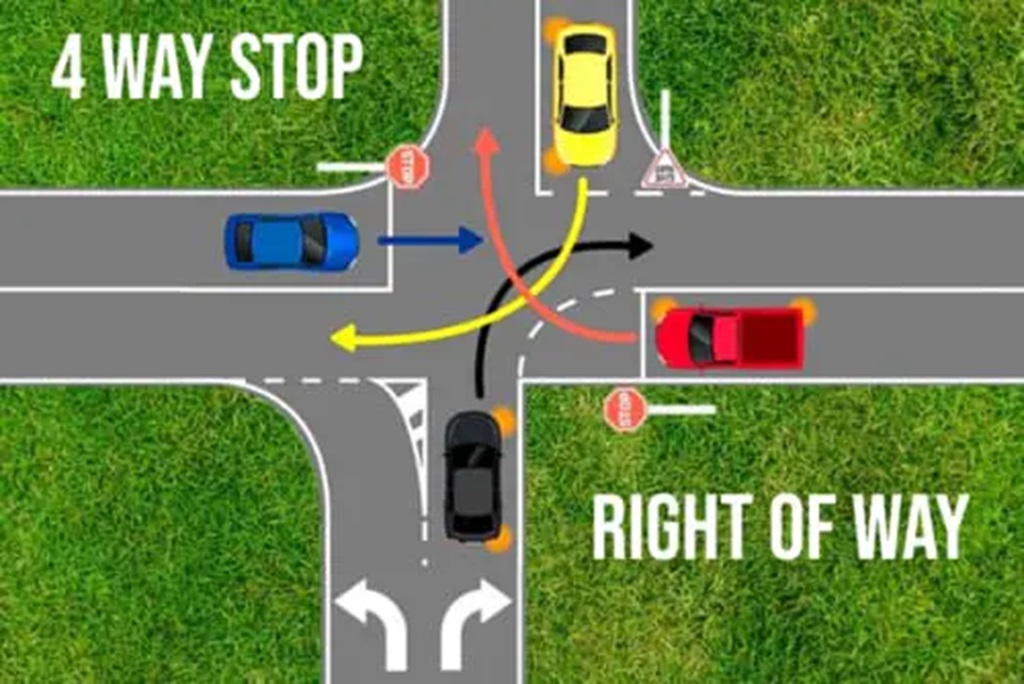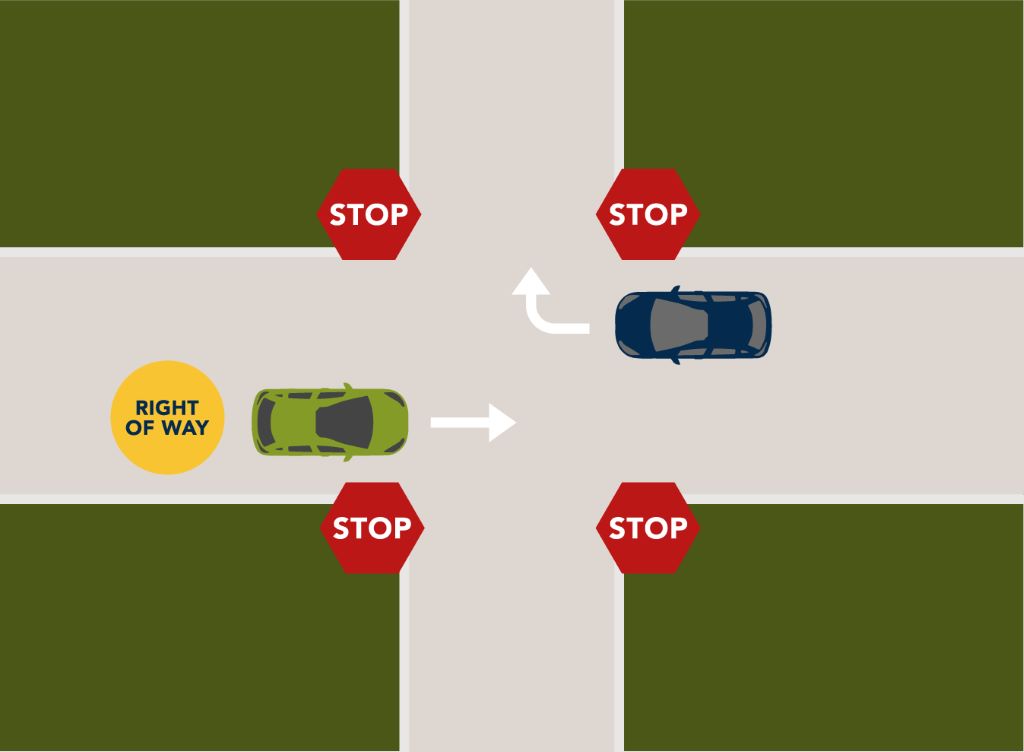
23 Dec How Does the Law Define Right of Way CVC 525
Driving on public roads means interacting with many other drivers. We all have to follow certain rules to make sure traffic flows smoothly and safely. One of the most important rules governs right of way – who has the legal right to proceed first through an intersection or roadway. Understanding right of way helps drivers navigate shared spaces courteously and legally. This article will explain how does the law define right of way cvc 525 and how it promotes road safety.
What Does “Right of Way” Mean?
Simply put, right of way refers to who gets to go first. It gives one road user priority over others in using a certain section of road. Common situations where right of way comes into play include intersections, merging lanes, pedestrian crossings, and more. The vehicle or road user with the right of way has the legal right to proceed before others.
For example, at a four-way stop sign intersection, the first driver to come to a complete stop gets the right of way. If two vehicles arrive at the same time, the driver on the right goes first. Understanding and respecting right of way keeps traffic flowing smoothly by eliminating guesswork and confusion. No one should assume they automatically have the right of way – legal right of way is decided based on road position, traffic signals, signs, and safe driving practices.

Why Following Right of Way Matters
Besides helping coordinate the sharing of road space, following right of way rules serves some important safety purposes:
- Prevents collisions: Respecting others’ right of way gives a clear structure for taking turns and avoiding conflicting vehicle paths. Running stop signs, ignoring yield signs, or barging through intersections against the rules greatly raises the chance of crashes.
- Allows defensive driving: When everyone follows standardized right of way rules, drivers can predict others’ moves and take quick preventive action. Defensive techniques like covering the brake and looking both ways before entering an intersection work best within an orderly flow based on legal right of way.
- Supports legal justice: Right of way determines fault after collisions. Failing to yield right of way often constitutes illegal negligent driving. Following the standards protects innocent parties from blame and legal penalties.
In short, right of way aims to create order amid busy, chaotic roads with vehicles moving at high speeds. Violating these pivotal rules causes public endangerment even if an actual collision doesn’t occur.
What California Vehicle Code Section 525 Says About Right of Way
Within California state law, the rules of the road stem primarily from the California Vehicle Code. Section 525 specifically covers the thorny issue of right of way from several angles:
- (a) Except as otherwise provided in this chapter, the driver of a vehicle approaching an intersection shall yield the right-of-way to any vehicle which has entered the intersection from a different highway.
(b) (1) When two vehicles enter an intersection from different highways at the same time, the driver of the vehicle on the left shall yield the right-of-way to the vehicle on his or her immediate right, except that the driver of any vehicle on a terminating highway shall yield the right-of-way to any vehicle on the intersecting continuing highway.
Let’s break down what each piece means:
Part (a) – Intersections With Traffic Already Present
This part introduces a default right of way rule for intersections. When a vehicle pulls up to an intersection and there is already another vehicle present that entered from a different road, the existing vehicle has the right of way.
For example, you cannot just turn left across the path of an oncoming car already traveling straight through the intersection. Even if you arrived first, they entered the area before you did, so legally they have the right to proceed unimpeded. You must wait your turn.
Part (b)(1) – Vehicles Arriving Simultaneously
Now imagine two cars pull up to a 4-way stop sign intersection at the exact same time. Who gets to inch forward first?
Section 525(b)(1) establishes what is known as a “right hand priority rule.” If vehicles reach an intersection simultaneously from different roads, the one on the right gets the right of way.
So in our example, the car on the right-hand side of the intersection can legally proceed straight through or turn left in front of the other car. The driver on the left must wait. If collision occurs, the car on the left would likely be found at fault for failure to yield.
Part (b) Also Addresses Terminating Vs Continuing Roads
Vehicle Code Section 525 concludes by assigning right of way where terminating and continuing roads intersect:
“Except that the driver of any vehicle on a terminating highway shall yield the right-of-way to any vehicle on the intersecting continuing highway.”
A terminating road ends at the intersection, like a cul-de-sac, T-intersection, or freeway offramp. A continuing road keeps traveling past the junction. So imagine an offramp dumping traffic onto a major highway – vehicles entering from the ramp must yield to those already on the highway.
Other California Vehicle Code Sections that Define Right of Way:
While CVC Section 525 provides the baseline right of way rules for intersections and roadways, numerous other Code sections flesh out specifics:
- CVC 21800 – Right of Way at Intersections with Stop Signs
- CVC 21801 – Vehicle Turning Left Yielding to Oncoming Traffic
- CVC 21802 – Vehicle Entering Roadway Yielding Right of Way
- CVC 21950 – Right of Way Crossing Sidewalks
- CVC 21951 – Pedestrian Right of Way at Crosswalks
- CVC 21952 – Pedestrian Yielding Right of Way Outside Crosswalks
Plus separate sections cover right of way scenarios involving emergency vehicles, funeral processions, highway construction zones, and rail crossings.
Bottom line – the Vehicle Code aims to map out right of way across every conceivable traffic tangle. Mastering the standards equips conscientious drivers to navigate roads safely and legally.
Exceptions to Standard Right of Way Rules
While Section 525 sets key right of way precedents, it also notes “except as otherwise provided in this chapter…” Not every situation necessarily defaults to those fundamental yield and priority rules.
Some common exceptional cases where standard right of way gets overruled include:
Traffic Control Officers Directing Traffic
Police officers, crossing guards, construction flaggers, and other officials legally direct right of way on California roads. Obey their signals and temporary traffic control even if it contradicts usual right of way.
For example, an officer may stop you at an intersection and wave other vehicles through across your path. You must sit patiently until signaled to proceed.
Traffic Lights and Control Devices
Red-yellow-green traffic signals and other posted traffic control devices like stop signs override normal yielding protocol. You must comply with those instead at controlled intersections, even if the device wrongly seems to give right of way to nobody or vehicles that shouldn’t have priority.
If lights or stop signs are broken, non-working, or uncontrolled intersections have no postings, revert back to the standard yield rules. Never just blow through.
Turning Against a Red Arrow
You cannot turn against a red arrow onto a roadway, even if no approaching vehicle currently has right of way traveling straight across your desired path. The red arrow legally prohibits all conflicting vehicle movements. Sit tight until you get a green signal authorizing your turn.
Passing on the Right
Section 525(b)’s right hand priority rule does not apply to passing slow vehicles on the right. Cars driving slowly in the left lanes should proactively move to the right. But where they fail to do so, faster traffic may legally pass to the right when safe after signaling intent.
The DMV recommends passing on the left whenever feasible. But the Vehicle Code carves out allowance to pass right when traffic conditions warrant doing so with caution.
Traffic Breaks
Certain vehicles like ambulances, police cars, and fire trucks get traffic break right of way privileges under California law. We are required to make way for them to pass, pull over when they approach behind us, and yield at intersections when they need to turn across lanes with lights and sirens activated. Make sure you safely clear a path.
School Buses
When school bus lights flash red to load or unload children, we must stop in both directions until the bus turns signals off, with no exception for right hand priority or even green traffic lights. School children crossing the road to board have unconditional right of way in this situation.
Cyclists at Bicycle Lane Intersections
When you turn across a bicycle lane, cyclists going straight get the right of way over your turning vehicle. You must signal and point your wheels straight until all approaching bikes and pedestrians clear before cutting left or right across their path. Cyclists shouldn’t have to brake hard or swerve at the last minute due to a surprise turn.
These and other lawful exceptions remind us that while Section 525 sets helpful baseline right of way rules, no single statute governs every complex traffic tangle. Pay attention and apply legal safety rules flexible to circumstance. When in doubt, simply practice the golden rule – let others go first and exercise caution.
Pedestrian Right of Way
Vehicles must yield right of way to pedestrians legally crossing intersections and roadways in California. Separate Vehicle Code sections strictly define pedestrian right of way rules to protect walkers:
- Marked & unmarked crosswalks – Always yield to pedestrians at both marked and unmarked crosswalk junctions without exception. This counts even if they seem to be jaywalking against a Don’t Walk sign or crossing point with no painted lines.
- Blind, disabled pedestrians – Drivers must yield not only to sighted pedestrians, but also blind walkers carrying canes, disabled people using mobility aids, small children, and anyone obviously needing time to shuffle across busy lanes.
- Passing stopped cars – Watch for pedestrians emerging from stopped or parked cars near your intended path. Open your doors carefully too.
- Driveways, alleys intersections – Check both ways before pulling into roadways from driveways, alleys, and minor intersections in case a pedestrian crosses your path.
Failing to yield carries heavy $250+ citations, especially involving fatalities. When pedestrians have right of way, give them plenty of margin to make it across safely without feeling rushed by your waiting vehicle idling nearby.
Common Right of Way Confusions
Despite California’s meticulous statutes spelling out right of way in manifold situations, everyday driving still produces head-scratchers for both motorists and pedestrians. Here are some top areas of confusion:
- Multi-way stops – Who goes first when multiple cars reach an all-way stop simultaneously? Defer to vehicles on your right, but if in doubt, nonverbally communicate with other drivers to decide order and avoid gridlock.
- Uncontrolled T-intersections – Cars on the terminating road arriving simultaneously should yield to through traffic. But some argue the continuing straight road should alternatively yield right. Clarity gets murky without signs.
- Jaywalking pedestrians – Do pedestrians ever have to yield crossing outside of intersections without signals? Technically yes rarely when no crosswalk exists, but in practice, cars usually yield anyway due to severe consequences for collisions.
- Passing cyclists – When bicycles take the traffic lane, it often bewilders motorists if bikes have automatic right of way prohibiting passing, or whether drivers can carefully advance when prudent.
- Yellow light rights – Can you still enter intersections under stale yellow, or should you instead brake for vehicles hastily trying to make the light from other directions? Interpretations vary.
As you see, many gray areas remain open for drivers to debate who gets ultimate priority. It often just comes down to judgment calls factored by safety. When both parties defer to each other, confusion gets more confused. But progress happens when one party decisively takes the initiative to advance after signaling – either by waving the other(s) ahead or cautiously proceeding in turn after waiting without obvious objection.

How to Keep Right of Way Straight
We covered extensive ground explaining right of way rules while noting gaps that still confuse drivers. How can you master this pivotal but messy traffic concept? Here are 5 simple tips:
- Brush up on Code sections – At least give CVC 525 a fresh read plus intersecting statutes on stop signs, turns, and pedestrian focus areas. Knowing the written standards makes applying them easier.
- Assume nothing – Never presume cars or pedestrians recognize your right of way or will stop without explicit communication. Make eye contact and be sure others see your signals and presence before proceeding into any busy road space.
- Wave others to clear confusion – When mutually waiting to turn through intersections, a friendly hand wave or alternating light flash can help indicate orderly yielding intentions and prevent awkward gridlock.
- Focus on safety, not legal technicalities – Avoid antagonistic debates over right of way finer points. Follow the overarching rule of avoiding collisions at all costs.
- Practice patience and sharing – Finally, default to letting others go first whenever reasonable, whether or not you technically have priority. Driving safely means accommodating people ahead of yourself.
In this spirit of safe accommodation and communication, right of way confusion irons itself out into a orderly flow. We get where we need to go not by demanding roadways center around our vehicle, but by actively calibrating all traffic participants’ movements into cooperative harmony.
Frequently Asked Questions
- If I arrive at a four-way stop first, do I have the unconditional right of way?
No. All vehicles must come to a full and complete stop at four-way intersections before legally proceeding through, regardless of arrival order. So another driver who stops later may still acquire right of way over you if they entered the actual intersection first after stopping. First to stop does not automatically grant right of way.
- When I am waiting to turn left, can I pull partway into the intersection under a green light?
Yes, with caution. You may pull your vehicle into the middle of the intersection while waiting for a break in oncoming traffic to finish your left turn. However, wait for ongoing vehicles to pass before pulling forward. Never block earlier traffic by sitting in the intersection. And clear the junction before the light turns red to avoid being stuck blocking other flows.
- Does a flashing yellow arrow traffic light function the same as a normal green light?
No. Green circles indicate clear unconditional right of way to proceed straight or turn. But flashing yellow arrows require you to yield, slow significantly, and turn only with extreme caution when no oncoming traffic nears. Treat flashing yellow arrows more like flashing red lights in terms of mandatory cautious yielding rather than as normal green go signals.
- If I enter an intersection legally but traffic backs up blocking my passage, am I illegally blocking traffic?
No. So long as you entered with proper signaling and right of way clearance, you aren’t to blame if bottlenecked vehicles abruptly cut off passage mid-junction. Exit safely when able, but the fault lies with rear vehicles following too closely or overflowing available road space. Just don’t intentionally enter knowing traffic clearly backups beyond your clearance.
- Can I assume pedestrians always observe lawful crossing rules and therefore expect them to yield accordingly?
Absolutely not. While pedestrians should ideally cross with the signals legally, you as the motorist bear responsibility to anticipate sudden jaywalking, distraction, or other unpredictable behavior. Drive prepared to stop or evasively act regardless of signals if a pedestrian seems likely to step into your path against the rules. Safety trumps technical illegalities.
Final Words
Driving involves constant judgment calls and negotiations to balance self-interest against community accommodation. Nowhere does this play out more clearly than in practicing right of way etiquette on the daily commuting road.
As we covered, California Vehicle Code Section 525 establishes helpful baseline intersection rules, while additional laws fill in other traffic scenarios. But ultimately, safely navigating busy thoroughfares relies as much on courtesy conduct as codified legalities.
It takes proactive communication, eye contact, hand signals, and small acts of yielding to keep traffic running smoothly. Navigating the intricate realm of Vehicle maintenance law: Rights and responsibilities requires a nuanced approach, as reliance on laws alone creates brittle, antagonistic driver relationships. Embracing flexible, human-centered accommodation, however, serves as the lubricant needed to sustain a harmonious and effective system.
Yes, firmly understand your technical legal right of way privileges to avoid misplaced fault after collisions. But wield that right gently rather than antagonistically in nitpicking legal gray areas. Where ambiguity confuses, let others proceed first.


No Comments